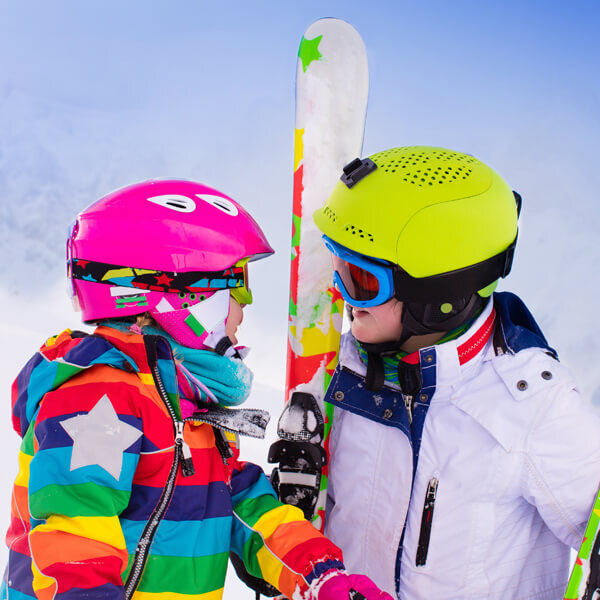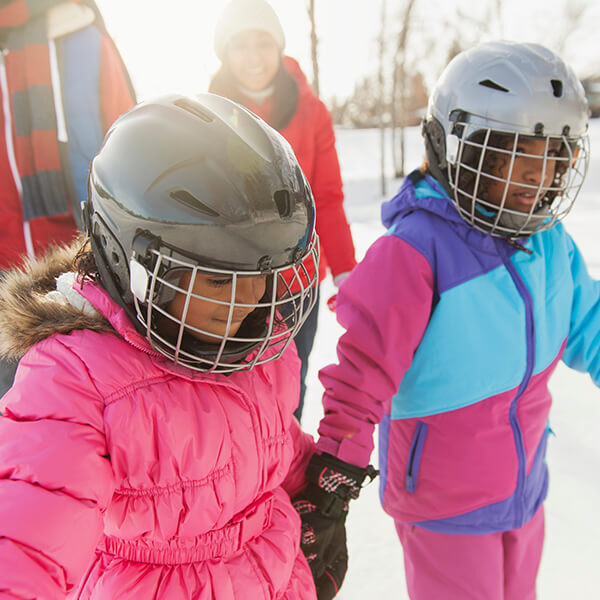Winter Safety
The Facts
- Each year in the United States, 25,000 children under age 15 are seen in the emergency department for sledding injuries.
- Children under 15 account for most of the sledding injuries seen at trauma centers.
- Experts estimate that more than 13,000 injuries annually are related to snowboarding or downhill skiing in kids under 15. About 5% of those injuries required hospital admission.
- Nearly 82% of children treated for a sledding-related injury sustained an injury to the head.

What Parents Can Do
Make sure kids are wearing the right gear for both the weather and the activity.
Appropriate clothing is necessary to prevent frostbite and hypothermia. A child's smaller body is more vulnerable to the cold.
Check out this video from Stanford Medicine Children’s Health for tips on what clothing is appropriate.
Appropriate safety gear for skiing, sledding, snowboarding, and hockey are necessary for preventing injuries.
Here is a guide on appropriate winter safety gear from Seattle Children’s Hospital (available in English and Spanish), or click below to download an English or Spanish version of the guide.

Make sure kids are safe
Always check that the area is safe.
Make sure that the sledding or snow play area is away from traffic and parked vehicles.
Don’t sled until the sledding area is clear of other people or objects.
Make sure ice is not thin before skating, playing hockey or ice fishing.
Never use makeshift sleds like pool floats, plastic bags, or garbage can lids.
They're risky and can cause you to lose control. Never use a sled that has any broken sections or sharp edges. Older sleds might have this kind of damage.
Make sure kids take breaks throughout the day to go inside and warm up.
Kids can struggle to notice when they need to take a break from the cold. Make sure they take some breaks to warm up. It's a perfect opportunity for hot cocoa!
Grab a safety buddy.
When skiing and snowboarding, make sure kids pair up and stay near their safety buddy. Safety buddies can double check each other’s gear and in case of a head injury, a safety buddy can get help.

WINTER SAFETY GEAR


For skiing and snowboarding:
- Choose a certified helmet made just for snow Sports.
- Look for a helmet that meets ASTM F2040, Snell RS-98 or S-98 standards.


For ice hockey:
- Choose a helmet with a face guard that meets the NOCSAE standard and has been approved by the Hockey Equipment Certification Council (HECC).


For sledding and ice-skating:
- Currently, there are no helmets designed for sledding or ice-skating, but the American Academy of Pediatrics advises that wearing a helmet is better than not wearing one at all.
- Choose a helmet that meets one of the following safety standards:
- Bike helmet: CPSC, ASTM F1447, Snell B-90/95 or N-94
- Skateboard helmet: ASTM F1492, Snell N-94
- Snow sport helmet: ASTM F2040, Snell RS-98 or S-98
Good idea or bad idea?
Test yourself!
Be Prepared
Check out this guide to Winter Sports Safety Tips! Click below to download.

Resources
Check out these links to learn more!
HealthyChildren.org
A guide for parents to prevent Frostbite and Hypothermia
Cold Weather Safety for Children
Stanford Medicine Children's Health
A video guide for parents with tips on what clothing is appropriate for cold weather
How to keep your children safe during the winter
The Consumer Product Safety Commission
A guide for choosing the right helmet for all kinds of sports and activities
Which Helmet for Which Activity
The Centers for Disease Control and Prevention
Fact sheets for several types of helmet
Guides for Ski and Snowboard Helmet Safety with tips for wear and care
